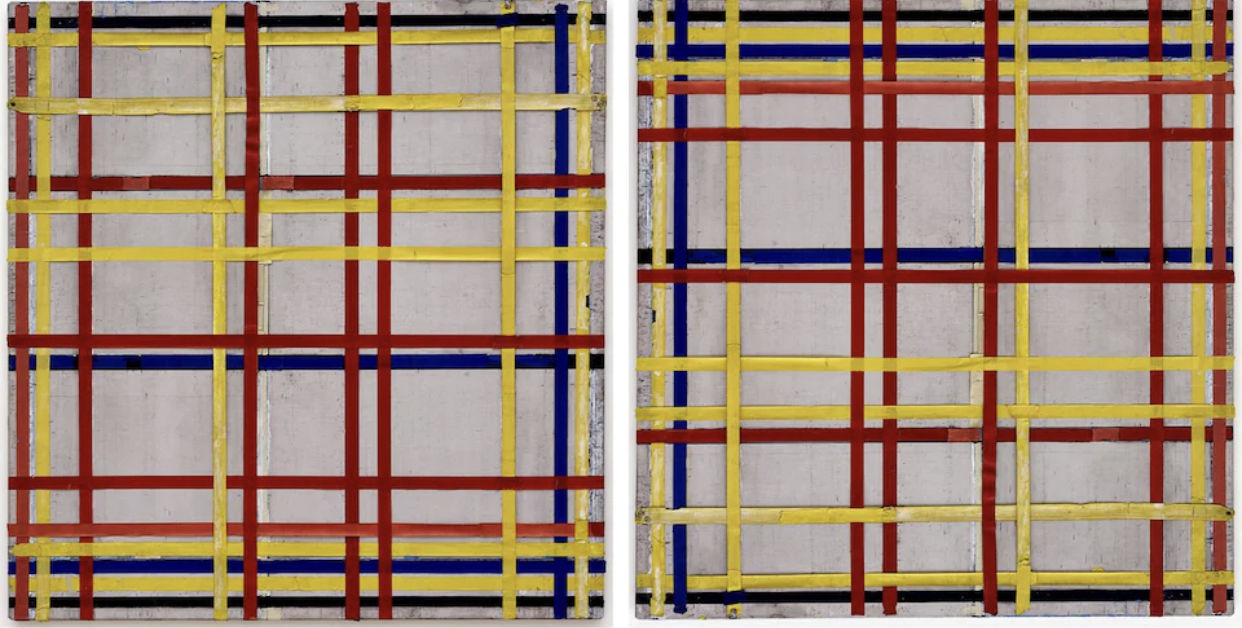A Mondrian Work to Have Been Hung Upside-Down for Over 75 Years

At a press conference on the eve of Mondrian. Evolution, a Piet Mondrian exhibition at Germany’s Kunstsammlung Nordrhein-Westfalen K20 museum, curator Susanne Meyer-Büser announced that the exhibition’s highlight, New York City 1 (1941), has been displayed upside down since it was first seen in public, German publication Monopol .
Iranart: At a press conference on the eve of Mondrian. Evolution, a Piet Mondrian exhibition at Germany’s Kunstsammlung Nordrhein-Westfalen K20 museum, curator Susanne Meyer-Büser announced that the exhibition’s highlight, New York City 1 (1941), has been displayed upside down since it was first seen in public, German publication Monopol reported Thursday.
The first clue that the painting, an adhesive tape version of the similarly named New York (which hangs right-side up in Paris at the Centre Pompidou), was hung incorrectly came from a photograph of the artist’s studio in taken in 1944, shortly after he passed away, the curator said at the press conference. In the photo, New York City 1 can be seen on an easel with the tightly grouped yellow, blue, and black stripes at the top.
Could it be that the orientation shown in the photo is the actual one Mondrian had intended?” the curator asked. According to Meyer-Büser the picture was first shown at New York’s Museum of Modern Art in 1945. There, too, the thick grouping of stripes was shown at the bottom of the work instead of at the top. “Was it coincidence, was it oversight?” she said, adding that perhaps it was flipped over while being unpacked at MoMA over 75 years ago.

Meyer-Büser claims to have proof beyond the photograph taken on Mondrian’s studio. She believes the artist would have worked from top to bottom, carefully layering the strips of tape over one another, weaving them together in a specific way, a feat that would be much more difficult if he worked from the bottom up.
Further, at what is currently the top of the picture, the tape is harshly torn and does not reach the edge of the canvas—another sign that Mondrian likely worked from top to bottom.
Regardless, the work will be displayed at Mondrian. Evolution, which chronicles Mondrian’s stylistic development, the way it has been since 1945, unclean ends up, thick grouping of horizontal tape at the bottom.
“If I turn the work around, I risk destroying it,” Meyer-Büser said, according to Monopol, and besides “maybe there is no right or wrong orientation at all?”
New York City 1 is not the only time that the MoMA supposedly displayed a work the wrong way. In 1961, during the museum’s exhibition of work by Henri Matisse, a stockbroker named Genevieve Habert noticed the paper cut La Bateau was hung upside down. Neither the museum staff, the 116,000 visitors, nor the artist’s son Pierre had realized the mistake.
After multiple visits, Habert bought a catalogue and discovered she was right, only to be scoffed at by museum staff. She then approached the New York Times, which reported on the topsy-turvy cut out.
Shortly after publication, MoMA curators took a second look and ultimately rehung the picture the correct way. “Mrs. Habert should be given a medal,” Pierre Matisse told the Times.

